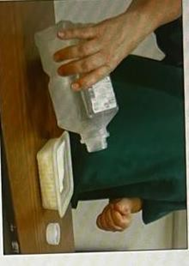When preparing to change a client's sterile dressing, the nurse pours sterile solution over a package of gauze pads as seen in the picture. Which should the nurse do next?

Position the package of gauze pads on a sterile field.
Discard the open bottle of solution before continuing.
Recap the solution and apply a pair of sterile gloves.
Obtain all new supplies and start the procedure again.
The Correct Answer is A
A. Positioning the package of gauze pads on a sterile field is an appropriate action to maintain sterility and ensure that all items used in the procedure remain uncontaminated. However, this step should be considered only if the solution was poured correctly and the sterility of the gauze pads and solution has been maintained.
B. Discarding the open bottle of solution is not necessary unless it has been contaminated. If the solution is still sterile and has not been contaminated (e.g., by touching non-sterile surfaces), there is no need to discard it. The focus should be on ensuring that the solution and all other items remain sterile.
C. Recapping the solution is not recommended because it can lead to contamination. Instead, the solution should be left open or covered with a sterile cap, if provided. Applying sterile gloves is essential for maintaining sterility during the dressing change procedure, but this should be done after ensuring that all supplies and steps are in order.
D. This action would be necessary only if there was a contamination issue or if the sterility of the supplies or solution was compromised. If the sterile technique was not followed properly or there was a risk of contamination, starting the procedure again with new supplies would be appropriate.
Nursing Test Bank
Naxlex Comprehensive Predictor Exams
Related Questions
Correct Answer is A
Explanation
A. Assessing the client for pain is a crucial step because pain can cause disorientation and agitation, especially after surgery. Pain might be a reason for the client's behavior. Addressing pain effectively can help improve the client’s comfort and potentially reduce disorientation and risky behavior.
B. Applying wrist restraints should be considered a last resort and only when other interventions are not effective or if there is an immediate danger to the client. Restraints can increase agitation and potentially lead to other complications.
C. Determining the client's blood pressure can be important, especially if there are concerns about hypotension or other cardiovascular issues that might contribute to disorientation. However, it is usually more effective to first address potential pain or discomfort.
D. Administering a sedative may be appropriate in cases of severe agitation or disorientation, but it should not be the first action. It is essential to first identify and address any underlying causes of the client’s behavior, such as pain, before resorting to pharmacological interventions.
Correct Answer is A
Explanation
A. High doses of fish oil can indeed increase the risk of bleeding, particularly because fish oil has anticoagulant properties that can interfere with blood clotting. This risk is especially significant if the client is also taking other anticoagulant or antiplatelet medications.
B. While it is true that fish can be heart-healthy due to its omega-3 fatty acids, this statement does not fully address the concerns about the safety of high doses of fish oil supplements. Eating fish in moderate amounts is beneficial, but the focus here is on the effects of large doses of fish oil supplements, not just consuming fish. The safety of high doses should be considered separately.
C. Encouraging the client to increase the dose of fish oil is not appropriate without considering potential side effects and risks. High doses of fish oil can lead to gastrointestinal symptoms like nausea, diarrhea, and indigestion.
D. Not all types of oils increase cholesterol and triglycerides. For instance, omega-3 fatty acids found in fish oil can actually help lower triglyceride levels and may have a positive effect on cholesterol levels.
Whether you are a student looking to ace your exams or a practicing nurse seeking to enhance your expertise , our nursing education contents will empower you with the confidence and competence to make a difference in the lives of patients and become a respected leader in the healthcare field.
Visit Naxlex, invest in your future and unlock endless possibilities with our unparalleled nursing education contents today
Report Wrong Answer on the Current Question
Do you disagree with the answer? If yes, what is your expected answer? Explain.
Kindly be descriptive with the issue you are facing.
